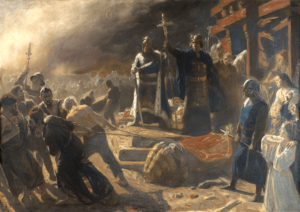Business & Education
Who needed the Holy Land when they could fight a crusade on their doorstep?
This article is more than 9 years old.
The first, the third, the last, the children’s … and now you can add the Danish, even if there were concerns over whether Denmark’s 12th century war with the Wends had any religious motivation whatsoever

Archbishop Absalon had the pagan idol Svantevit destroyed (photo: Laurits Tuxen)
Throughout the 12th century, Danish forces raided the northern coasts of Germany and Poland time and time again. The aim was to fight the region’s pillaging pagans, the Wends, a mixture of tribes that in turn attacked the Danish coastline with regularity – raids that were particularly unwelcome during a Danish civil war from 1146-57. Despite times of peace, trade and even intermarriage between the Danes and the Wends (Harald Bluetooth was indeed married to a Wendish princess), they were feared and hated by all in Denmark.
In 1147 Pope Eugene III declared the Second Crusade in an attempt to reconquer the Holy Land from the Muslims in the Middle East. Concurrently, holy war was also made a universal principle. This meant that any war waged against the enemies of god – such as the heathen Wends – was now viewed by the church as a holy war and would grant the Christian warriors divine privileges. The Danish Crusades were quickly proclaimed.
The warring parties laid down their arms and put the civil war on hold, so they could do god’s biding. They joined the princes and dukes of northern Germany in the fight against the heathens in their backyard. The Saxons had been granted permission to fight the Wends by a powerful abbot, Bernard of Clairvaux, rather than joining the Second Crusade to the Holy Land, as other Germans had done. Their decision made good financial sense. Expeditions against the Wends were much easier to organise and considerably cheaper than joining the crusade to the Holy Land. It also opened the door to a future taxation of their defeated neighbours.
Wended up negotiating
Alas, it did not go very well for the Christian forces. The Danes and the Saxons were unable to defeat the Wends and ended up negotiating a peace agreement. The Wends agreed to release their prisoners and accept the Christian faith as their own, but almost as soon as the Saxons and Danes turned their backs, they returned to their pagan ways and escalated their attacks on the coasts of Denmark, which was once again embroiled in civil war.
But they hadn’t reckoned on Valdemar the Great, who became king of Denmark in 1157 after decisively ending the civil war in victory. He immediately launched an attack on the Wends, whose attack on Denmark had never stopped during the civil war, and over the next 15 years he completed approximately 20 expeditions against the Wends.
He joined forces with his old enemy Henry the Lion, the duke of Saxony, in a shaky alliance. Rather than just guarding themselves against Wendish aggression, the two leaders expanded into the Wendish areas. Henry the Lion was more successful, since he had a large population that he could use to colonise the newly conquered areas. Valdemar, on the other hand, could not find Danes willing to accept the task of settling in the Wendish areas. It was simply too dangerous.
Svantevit smited
The Danish activity culminated with the historic conquest of the pagan stronghold of Arkona in 1168. The fall of Arkona signalled the Danish conquest of the island of Rügen and is described in detail by the Danish chronicler Saxo. He described how King Valdemar and Archbishop Absalon (the founder of Copenhagen no less) had the pagan idol Svantevit destroyed. Not only was the big wooden idol chopped to pieces, they used the pieces as firewood and cooked the victory feast for the troops with it, whilst the pagan temple was stripped of its treasures.
The population of Rügen was then christened and the island remained under Danish rule until 1325, while the Danish church remained in charge of ecclesiastical matters until 1660.
To this day, Danish scholars are still arguing whether or not the Danish expeditions against the Wends were crusades. The motives seem to have been very mixed indeed. An example is the conquest of Arkona, which was characterised by pillaging and taxation of the area on one hand, but also the building of churches and other religious institutions on the other hand. Historians agree that the expedition of 1147 can rightly be called a Danish crusade as it was initiated by the Pope, who promised indulgence. But that is about it.
Crusade or Vendetta?
Some historians believe that all the Danish expeditions were crusades based on their claim that religious motives were the main reason for the expeditions. They believe that the Pope’s proclamation of a holy war as a universal principle was still valid after the Second Crusade (1147-49). Other historians, in contrast, point to the Viking-like manner of the expeditions and argue that Saxo only described the expedition in 1147 as a crusade, whilst the others were described as conquests driven by vengeance against the pillaging Wends.
They believe that the religious motives were secondary and that the Pope gave up on the idea of a holy war outside the Holy Land after the fiasco of the Second Crusade, in which the christian forces failed to make progress in the Holy Land.
Regardless of the scholarly disagreement, the expeditions against the Wends led to a Danish heyday, during which the country succeeded in establishing itself as a dominant force in the areas surrounding the Baltic Sea – a supremacy that lasted until 1241.










































